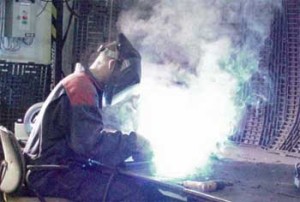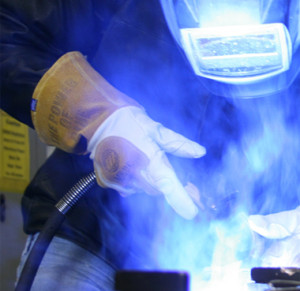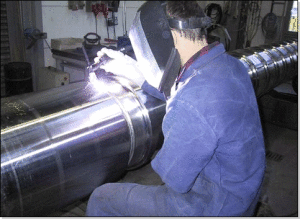Code & Safety
TIP TIG & ASME Code
TIP TIG is according to the ASME code considered a Hot – Wire process. Most weld shops that deal with code welds will have established TIG weld procedures and the welders will have qualified to the specific code TIG welder qualification requirements. ASME code shops who have established TIG procedures will find that with most TIP TIG welds that they do not have to requalify the welds, however the shops will want to add a revision to the procedures reference the TIP TIG wire feed rates utilized. Also qualified manual and automated TIG welders should not have requalify when they use the TIP TIG process.. The following is advice from Walt Sperko. Walt is one of the most qualified experts on the ASME code in North America.
TIP TIG & Weld Fumes
Every weld shop should be concerned about fumes.
As we are all aware, when weld shops weld stainless and nickel alloys there should be extensive concern about the safety and liability concerns with alloy applications which will generate hexavalent chromium content in the weld fumes generated. Weld fume generation and weld fume content are primarily influenced by the weld process, parameter and consumables selected. Weld shops should also be aware that with the stainless and nickel alloys there are other hazardous constituents such as nickel and manganese, two alloys which are rarely measured.
Fume Fact:
Both the Self Shielded and Gas Shielded Flux Cored process will generate the highest fume generation rate, (FGR) . With Gas Shielded Flux Cored, that FGR will be at it’s highest with straight CO2 and the fumes will be approx. 10 – 20% less when argon 20 – 25% CO2 is used. Note while the fume content is higher in gas shielded flux cored that utilizes straight CO2, in contrast, the hexavalent chrome is driven down as the CO2 content increases. The hexavalent reduction with CO2 is likely a result of the higher arc energy generated by the arc dissociation properties (molecule action) along with the increased energy from the higher voltage requirements that come from the highly reactive CO2..
 Fume Fact:
Fume Fact:
The two processes that will generate the highest chrome hexavalent content will be the Self Shielded flux cored process and the SMAW (stick) process.
Fume Fact:
SMAW fumes typically can generate more than 100% hexavalent chrome than any other weld process, however as the stick process weld duty cycle times are low, a welder may have as much hexavalent chrome or other alloy exposure from the higher deposition, higher current, longer arc on time flux cored process.
Fume Fact:
While the weld shop may focus on hexavalent chrome content they may find that with the extremely new low threshold limits which will eventually be applied to manganese could make this alloy a greater problem to deal with.
 Gas shielded flux cored. Without knowing the alloys involved, you know these fumes are not good for anyone in the weld shop.
Gas shielded flux cored. Without knowing the alloys involved, you know these fumes are not good for anyone in the weld shop.
Fume Fact:
The higher the weld current used the greater the concern for the hexavalent chrome. The higher the CO2 content with both the MIG and Flux Cored process, the greater the fumes and spatter but the lower the hexavalent chrome.
Flux cored. With high weld current potential, high deposition rates and extended weld duty cycle times, this is the weld process that will provide extensive concern.
 Pulsed MIG, less fumes but still alloy hazards.
Pulsed MIG, less fumes but still alloy hazards.
Fume Fact:
Short Circuit, Pulsed MIG. Metal Cored and Spray transfer will provide much lower fume and hexavalent content than flux cored, however for those unprotected welders using the MIG process, fume hazards may still occur especially with the new threshold limits that may be imposed on manganese.
Fume Fact:
With MIG amd flux cored if you need to decrease hexavalent chrome, a decrease in current and an increase in CO2 will do that, however lets get back to the real world, you eliminate the weld fumes through ventilation and protect the welders with fresh air weld shields or you select the TIP TIG process.
Stainless Weld Fumes
 TIP TIG stainless weld fumes were measured during 2012 by one of the world’s largest construction equipment companies. The hexavalent chrome results were difficult to read and the lowest that have ever been recorded. This should surprise no one, after all it has to be difficult for industrial hygienists to measure what they cannot see.
TIP TIG stainless weld fumes were measured during 2012 by one of the world’s largest construction equipment companies. The hexavalent chrome results were difficult to read and the lowest that have ever been recorded. This should surprise no one, after all it has to be difficult for industrial hygienists to measure what they cannot see.
Take an Incoloy alloy 800, 0.045 (1.2mm) weld wire with approx. 32% Nickel and 22% Chrome. Then produce a large, single pass, 5/16 (8 mm) fillet made at > 320 amps, and you know you wont have to worry about the weld fumes with this TiP TiG weld.
The subject of weld fumes can be extremely complicated and every weld fume study seems to offer either a biased opinion from a consumable manufacturer or a fume study that contradicts the last one published. There is however one thing that every industrial hygenist will agree on. For the last five decades the regular TIG process has been the process in which the weld fumes generated are simply not a concern. Weld shops like the lack of TIG fumes, what they don’t like is the TIG process creates the highest weld costs.
Today you have another choice for welding alloys. Thanks to the faster TIP TIG weld speeds, TIP TIG will actually produce less weld fumes than regular TIG and when you examine the weld cost section at this site, you will find that from a weld cost perspective, TIP TIG can compete with MIG and flux cored.
